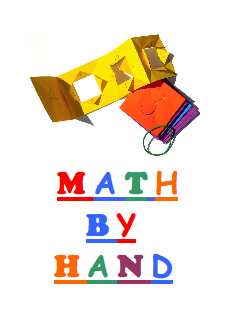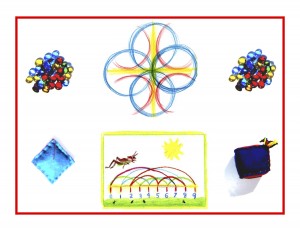
Day 157
For one year, 365 days, this blog will address the Common Core Standards from the perspective of creating an alternate, ambient learning environment for math. Ambient is defined as “existing or present on all sides, an all-encompassing atmosphere.” And ambient music is defined as: “Quiet and relaxing with melodies that repeat many times.
Why ambient? A math teaching style that’s whole and all encompassing, with themes that repeat many times through the years, is most likely to be effective and successful. Today’s post will continue reviewing the Common Core ELA standards, which are listed in blue and are followed by their ambient counterparts.
English Language Arts Standards > Speaking & Listening > Grade 2
Presentation of Knowledge and Ideas:
CCSS.ELA-LITERACY.SL.2.4
Tell a story or recount an experience with appropriate facts and relevant, descriptive details, speaking audibly in coherent sentences.
Storytelling is a daily occurrence in the Waldorf environment, by teacher/parents and students alike. In order for children to recount relevant descriptive details, they need to build a storehouse of ability to do just this. A recurrent, troubling aspect of the Common Core is that it consistently asks too much too soon, especially in the younger grades before the age of reason at 11 or 12. Until then they are learning how to relate, with the tools provided by the adults who teach them. Children learn to speak beautifully and clearly primarily through adult example. If the stories are told and lessons are given in a clear and flowing way, this is what teaches the child to speak beautifully and correctly. Retelling the story in great detail and saying poetry, tongue twisters, limericks, and clapping verses by heart will be more than enough to engender audible, coherent speech. Just not spontaneous, original speech, not yet. This is still forming, as the butterfly forms in the cocoon. Rush it at your and your child(ren)’s peril.
CCSS.ELA-LITERACY.SL.2.5
Create audio recording of stories or poems; add drawings or other visual displays to stories or recounts of experiences when appropriate to clarify ideas, thoughts, and feelings.
Audio recordings, no matter how technically perfect, are not the best fare for the young child. There is an inherent distancing quality that robs the developing being of its most crucial necessity, human contact. Your voice (ideally telling the story rather than reading it) enlivens the story, rhyme, or song with a nurturing human touch, more essential for healthy growth and development than just about anything else you can give. Now, drawings! Yes, those happen in abundance, every day, all day. The young child learns though the arts, which act as a beautiful intermediary between the child and any abstract concepts that are taught. It allows a translation so to speak, of the lesson into the language of childhood. Time enough for abstract learning later. Even then, beauty remains as a lifelong friend in a world that is increasingly dry and bereft of esthetic sustenance.
CCSS.ELA-LITERACY.SL.2.6
Produce complete sentences when appropriate to task and situation in order to provide requested detail or clarification.
That word: produce. It’s downright chilling when applied to children under 12 (or over 12, or adults for that matter). It implies a factory-model, production-oriented way of life, which is outmoded now, for reasons of survival: us and the planet. At any rate, complete sentences are routinely produced as the story is retold in faithful detail, and the literary, grammatical structure is effectively learned the way language was learned, by immersion and osmosis. Detail and clarification should not be asked of 8 year olds. They are still thinking in holistic terms, and are not yet able to dissect thoughts in this abstract way.
Knowledge ensues in an environment dedicated to imaginative, creative knowing, where student and teacher alike surrender to the ensuing of knowledge as a worthy goal. Tune in tomorrow to continue with the Common Core ELA standards and their ambient counterparts.
Tags:
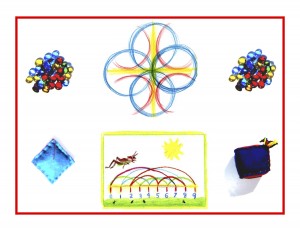
Day 156
For one year, 365 days, this blog will address the Common Core Standards from the perspective of creating an alternate, ambient learning environment for math. Ambient is defined as “existing or present on all sides, an all-encompassing atmosphere.” And ambient music is defined as: “Quiet and relaxing with melodies that repeat many times.
Why ambient? A math teaching style that’s whole and all encompassing, with themes that repeat many times through the years, is most likely to be effective and successful. Knowledge ensues in an environment dedicated to imaginative, creative knowing, where student and teacher alike surrender to the ensuing of knowledge as a worthy goal. Tune in tomorrow to continue with the Common Core ELA standards and their ambient counterparts. Today’s post will feature the fable “The Rooster and the Pearl” and how it can be related to the prime numbers. See below for the suggested drawing, and here’s the story:
A Rooster was once strutting up and down the farmyard among the hens when suddenly he spied something shining amid the straw. “Ho! ho!” said he, “that’s for me,” and soon rooted it out from beneath the straw. What did it turn out to be but a Pearl that by some chance had been lost in the yard? “You may be a treasure,” said Master Rooster, “to men that prize you, but for me I would rather have a single barley-corn than a peck of pearls.”
Precious things are for those who can prize them.
The prime numbers are divisible only by one and themselves. But, like the Pearl, the prime numbers are not as useful or practical as composite numbers. Because composites are factorable they, like the barley-corn, are commonplace, but more helpful. Primes can be sorted out from composite numbers by putting them through a “sieve” as the pearls might be sifted out from the corn. The Greek mathematician Eratosthenes invented a sieve to sift the prime numbers in the 2nd century BCE. This correlation is for you, the teacher. If you choose to share any of these facts, it needs to be done in a pictorial way. It may be enough to tell the story, have your child(ren) retell it the next day, then proceed to the activity and the drawing. To introduce this version of the prime numbers sieve say, “Let’s sift out the Pearls so the Rooster and Hens can eat!”
First you will need a square piece of paper. Here’s how to fold it into 100 squares (do have your child(ren) help with this!):
Start with a square piece of paper, at least 8 1/2″ (preferably plain white)
Fold it in half twice so you have four columns
Fold this in thirds (like a letter fold) so you now have 12 columns
Open the paper up and do the same folds the other way
You now have 144 boxes
Cut off or color the outside rows on all four sides
You now have 100 boxes.
Go over all the creases with a yellow pencil to outline the boxes.
Write the numbers 1-100 with a #2 pencil in each square. Then sift the primes! Cross out the non-prime numbers with one color, and circle the primes with another.
Cross 1 out/it’s not a prime
Circle 2/the only even prime
Cross out every 2nd number
Circle 3
Cross out every 3rd number/some may already be
Circle 5
Cross out every 5th number
Continue until all numbers are circled or crossed out.
ALL primes end in 1, 3, 7, 9 (except 2 and 5)!!
And here’s how to teach the drawing (the Rooster section only):
Draw a large circle in the middle of the paper
Divide it with 5 vertical and horizontal gridlines
You now have 16 squares (this is the Roosters’ sieve)
Take any 4×4 section of the primes chart
Copy it into the grid
The prime numbers should be larger and circled
Lightly color them in, with sparkles
Composite numbers are smaller, as the yellow barley-corn kernels.
Color the yellow rooster beaks all around!
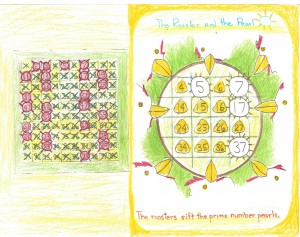
Tags:
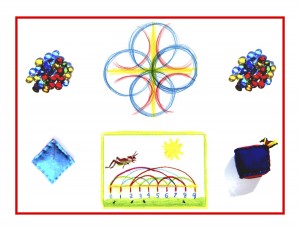
Day 155
For one year, 365 days, this blog will address the Common Core Standards from the perspective of creating an alternate, ambient learning environment for math. Ambient is defined as “existing or present on all sides, an all-encompassing atmosphere.” And ambient music is defined as: “Quiet and relaxing with melodies that repeat many times.
Why ambient? A math teaching style that’s whole and all encompassing, with themes that repeat many times through the years, is most likely to be effective and successful. Today’s post will continue reviewing the Common Core ELA standards, which are listed in blue and are followed by their ambient counterparts.
English Language Arts Standards > Speaking & Listening > Grade 2
Comprehension and Collaboration:
CCSS.ELA-LITERACY.SL.2.1
Participate in collaborative conversations with diverse partners about grade 2 topics and texts with peers and adults in small and larger groups.
“Collaborative conversations, peers and adults in small and larger groups.” Is this not more likely to be found as a college level lesson plan, a teacher development seminar activity, or at a human resources staff meeting? This sort of group activity is much more adult in nature, not suited to typical 8 year olds. Focusing on grade 2 topics and texts more often than not leads to the dumbing down of content in order to inappropriately allow independent learning at a too-young age. Provided the necessary adult support, second graders can successfully navigate classic, quality literature.
CCSS.ELA-LITERACY.SL.2.1A
Follow agreed-upon rules for discussions (e.g., gaining the floor in respectful ways, listening to others with care, speaking one at a time about the topics and texts under discussion).
Give and take, reasoned discussions should not be expected of this age group. If children are told (telling is preferable to reading) a classic story with excellent, inherently moral content, it will resonate deeply, to be drawn upon lifelong. The story will rest in a deep well of understanding so the next day, drawing upon extensive powers of memory and retention, it can be retold by the children. If the structure is set up at the beginning as one of attentive listening to the storyteller (the teacher on day 1 and children on day 2) this will be ingrained, with no need for reminders or reinforcement. The subject matter, if sufficiently compelling, is the best disciplinarian and will always result in excellent attention.
CCSS.ELA-LITERACY.SL.2.1B
Build on others’ talk in conversations by linking their comments to the remarks of others.
Conversation per se is not yet possible. Yes, second graders will relate in their talk and play, but in childish, playful ways. They are not ready for this adult, reasoned model. The story is the life lesson they want and need, without directly preaching or teaching anything. It can provide an integrated, connected whole, holding the storytellers in a cohesive group, unified by the strong will to be faithful to the story. This again is sufficient discipline, with no need for reminders or reinforcement.
CCSS.ELA-LITERACY.SL.2.1C
Ask for clarification and further explanation as needed about the topics and texts under discussion.
Discussion. From the classical Latin, discussus, “a shaking” or Old French, discutere, “to strike asunder, break up.” Originally “examination, investigation, judicial trial.” Not yet! Surely, the ability to reason (at age 11 or 12) must be present for this to happen. If the material (or story) is presented as an integral whole there is no need for clarification or further explanation. Yes, childish curiosity is always there, from the beginning, but it’s just not analytical yet.
CCSS.ELA-LITERACY.SL.2.2
Recount or describe key ideas or details from a text read aloud or information presented orally or through other media.
This happens naturally and beautifully, everyday, as each story is retold by the children. Every detail is faithfully recounted from the story that has been presented orally (told) by the teacher. No other media is used because the human connection is so essential for true, effective teaching and learning.
CCSS.ELA-LITERACY.SL.2.3
Ask and answer questions about what a speaker says in order to clarify comprehension, gather additional information or deepen understanding of a topic or issue.
Since understanding is occurring at such a deep level, there is essentially no questioning of it. Questioning implies reasoning, which is not yet fully present. Do you remember Virginia, who famously asked if Santa Claus was real? It just so happens that Virginia was 8 years old at the time! Please read her letter and its well-known reply, with this is mind: your 8 year old is not ready to take on the cares of the world, nor should s/he be expected to. See Virginia’s letter and the editor’s reply below.
Knowledge ensues in an environment dedicated to imaginative, creative knowing, where student and teacher alike surrender to the ensuing of knowledge as a worthy goal. Tune in tomorrow to continue with the Common Core ELA standards and their ambient counterparts.
| Eight-year-old Virginia O’Hanlon wrote a letter to the editor of New York’s Sun, and the quick response was printed as an unsigned editorial Sept. 21, 1897. The work of veteran newsman Francis Pharcellus Church has since become history’s most reprinted newspaper editorial, appearing in part or whole in dozens of languages in books, movies, and other editorials, and on posters and stamps. |
|
|
|
“DEAR EDITOR: I am 8 years old.
“Some of my little friends say there is no Santa Claus.
“Papa says, ‘If you see it in THE SUN it’s so.’
“Please tell me the truth; is there a Santa Claus? “VIRGINIA O’HANLON.
“115 WEST NINETY-FIFTH STREET.”
VIRGINIA, your little friends are wrong. They have been affected by the skepticism of a skeptical age. They do not believe exceptthey see. They think that nothing can be which is not comprehensible by their little minds. All minds, Virginia, whether they be men’s or children’s, are little. In this great universe of ours man is a mere insect, an ant, in his intellect, as compared with the boundless world about him, as measured by the intelligence capable of grasping the whole of truth and knowledge.
Yes, VIRGINIA, there is a Santa Claus. He exists as certainly as love and generosity and devotion exist, and you know that they abound and give to your life its highest beauty and joy. Alas! how dreary would be the world if there were no Santa Claus. It would be as dreary as if there were no VIRGINIAS. There would be no childlike faith then, no poetry, no romance to make tolerable this existence. We should have no enjoyment, except in sense and sight. The eternal light with which childhood fills the world would be extinguished.
Not believe in Santa Claus! You might as well not believe in fairies! You might get your papa to hire men to watch in all the chimneys on Christmas Eve to catch Santa Claus, but even if they did not see Santa Claus coming down, what would that prove? Nobody sees Santa Claus, but that is no sign that there is no Santa Claus. The most real things in the world are those that neither children nor men can see. Did you ever see fairies dancing on the lawn? Of course not, but that’s no proof that they are not there. Nobody can conceive or imagine all the wonders there are unseen and unseeable in the world.
You may tear apart the baby’s rattle and see what makes the noise inside, but there is a veil covering the unseen world which not the strongest man, nor even the united strength of all the strongest men that ever lived, could tear apart. Only faith, fancy, poetry, love, romance, can push aside that curtain and view and picture the supernal beauty and glory beyond. Is it all real? Ah, VIRGINIA, in all this world there is nothing else real and abiding.
No Santa Claus! Thank God! he lives, and he lives forever. A thousand years from now, Virginia, nay, ten times ten thousand years from now, he will continue to make glad the heart of childhood. |
|
|
Tags:
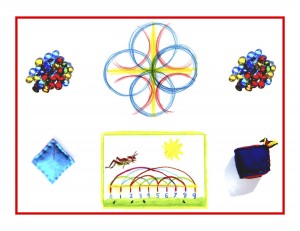
Day 154
For one year, 365 days, this blog will address the Common Core Standards from the perspective of creating an alternate, ambient learning environment for math. Ambient is defined as “existing or present on all sides, an all-encompassing atmosphere.” And ambient music is defined as: “Quiet and relaxing with melodies that repeat many times.
Why ambient? A math teaching style that’s whole and all encompassing, with themes that repeat many times through the years, is most likely to be effective and successful. No standards today. Rather I am offering a look at Waldorf seventh grade work. In the spirit of what can be accomplished without testing, and with faith and trust in the abilities of both teacher and student, please see that wondrous things are possible.
The images you see here are excerpts from seventh grade main lesson books, and the overall feeling is that of the medieval illuminated manuscript. Illuminated because the drawings are lit up with physical evidence of how deeply the lessons have been planted, as seeds that will grow to full fruition over a lifetime. Manuscripts because all text is neatly and beautifully written on unlined paper! Much discipline is needed to fill a blank page with handwritten text, a discipline that translates into self-discipline and responsibility toward lifelong learning. But please browse through the images, because a these pictures are worth thousands of words . . .
#mce_temp_url#
Waiting until the optimal time to work with higher reasoning skills, as is practiced with the Waldorf method, really pays off. No need to be anxious about your child not reading until 2nd, 3rd, or even early 4th grade! Why waste time worrying and fretting over anything when the end result is so spectacular? Research has shown that 94% of Waldorf students go on to college, and 50% pursue Masters degrees and PhD’s.
Knowledge ensues in an environment dedicated to imaginative, creative knowing, where student and teacher alike surrender to the ensuing of knowledge as a worthy goal. Tune in tomorrow to continue with the Common Core ELA standards and their ambient counterparts.
Tags:
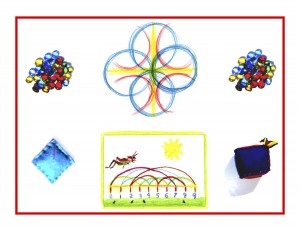
Day 153
For one year, 365 days, this blog will address the Common Core Standards from the perspective of creating an alternate, ambient learning environment for math. Ambient is defined as “existing or present on all sides, an all-encompassing atmosphere.” And ambient music is defined as: “Quiet and relaxing with melodies that repeat many times.
Why ambient? A math teaching style that’s whole and all encompassing, with themes that repeat many times through the years, is most likely to be effective and successful. Today’s post will begin reviewing the Common Core ELA standards, moving through them more quickly than the Common Core math standards. The standards will be posted in groups of three to five in blue, followed by their ambient counterparts.
English Language Arts Standards > Writing > Grade 2
Production and Distribution of Writing:
CCSS.ELA-LITERACY.W2.5
With guidance and support from adults and peers, focus on a topic and strengthen writing as needed by revising and editing.
Writing began in first grade as copying simple captions from stories heard and retold. Writing develops from there in a slow and steady progression, by copying longer sections of stories, and poems that have been learned by heart. Reading is learned through the writing that’s copied from the teacher’s sample. Independence in writing is slowly gained through strength of memory and repetition, while depending on the accuracy and integrity of the teacher’s writing skills, thereby learning how to write through examples of excellence. No revisions or editing yet.
CCSS.ELA-LITERACY.W2.6
With guidance and support from adults, use a variety of digital tools to produce and publish writing, including in collaboration with peers.
The guidance and support from adults is total, it’s the whole picture right now, as stated above. Peer collaboration is hardly applicable to second graders. As a group or individually, they are all still looking to the teacher for total guidance. Digital tools used for research can’t compare with a live teacher. Knowledge becomes wisdom when it is imparted from one human being to another. Waldorf students’ writing is beautifully produced and published as they construct their own textbooks: main lesson books, comparable to medieval illuminated manuscripts. (See below for examples of seventh grade main lesson books from the Cedar Springs Waldorf School in Placerville, CA.)
Research to Build and Present Knowledge:
CCSS.ELA-LITERACY.W2.7
Participate in shared research and writing projects (e.g., read a number of books on a single topic to produce a report; record science observations.
This sort of research writing needs to wait until reasoning has arrived, with the capacity for abstract thought at age 11 or 12. This maturity is evident in the seventh grade work shown below. Everything is beautifully illustrated and written by hand. Pride of craftsmanship and a reverence for every subject is there. The Waldorf educated child grows into a true world citizen in his or her own time, guided by the loving authority of the teacher, one that brings forth true discipleship in the students. Mentorship is a lost art in teaching, one that’s sorely needed and sadly lacking.
CCSS.ELA-LITERACY.W2.8
Recall information from experiences or gather information from provided sources to answer a question.
This sort of recalling and gathering is done in an informal way, in the course of any day at school or homeschool. It’s not yet made formal though. Recollection and memory is stronger now than it will ever be again, and if this quality is nurtured and developed, it will serve the older child and adult well. But again, the key is not to formalize too soon.
Knowledge ensues in an environment dedicated to imaginative, creative knowing, where student and teacher alike surrender to the ensuing of knowledge as a worthy goal. Tune in tomorrow to continue with the Common Core ELA standards and their ambient counterparts.




Tags:

Day 152
For one year, 365 days, this blog will address the Common Core Standards from the perspective of creating an alternate, ambient learning environment for math. Ambient is defined as “existing or present on all sides, an all-encompassing atmosphere.” And ambient music is defined as: “Quiet and relaxing with melodies that repeat many times.
Why ambient? A math teaching style that’s whole and all encompassing, with themes that repeat many times through the years, is most likely to be effective and successful. Today’s post will begin reviewing the Common Core ELA standards, moving through them more quickly than the Common Core math standards. The standards will be posted in groups of three to five in blue, followed by their ambient counterparts.
English Language Arts Standards > Writing > Grade 2
Text Types and Purposes:
CCSS.ELA-LITERACY.W2.1
Write opinion pieces in which they introduce the topic or book they are writing about, state an opinion, supply reasons that support the opinion, use linking words (e.g., because, and, also) to connect opinion and reasons, and provide a concluding statement or section.
Second graders may have opinions, but cannot yet have “reasoned” opinions. Their age and developmental stage precludes this sort of abstract, objective thinking. As always however, a strong and solid foundation is built as they listen to and faithfully recount the wide variety of literature that is presented to them throughout the year. Sound literary structure is exemplified constantly, to be drawn upon later when the time is right for essay writing.
CCSS.ELA-LITERACY.W2.2
Write informative/explanatory texts in which they introduce a topic, use facts and definitions to develop points, and provide a concluding statement or section.
It’s been said that the best tool for learning how to write well is reading, a lot. And even though Waldorf second graders are most likely not yet reading, they are learning to love literature, which is the single most important factor toward insuring excellent readers and writers. The stories told and retold by the children are taken from classic literature, and as such are excellent examples of the literary elements listed above (topic, development, and conclusion). After years of exposure to this rich story content, Waldorf students are ready and able to write well about virtually any subject.
CCSS.ELA-LITERACY.W2.3
Write narratives in which they recount a well-elaborated event or short sequence of events, include details to describe actions, thoughts, and feelings, use temporal words to signal event order, and provide a sense of closure.
Again, all of this occurs but not in writing yet. As a story is retold every day, it covers all of the above. The extent to which every minute detail is remembered and recounted by the children is nothing less than astounding. This gift of memorization will fade with age, and if it’s not nurtured by allowing the children the opportunity to retell stories and memorize long verses by heart, something inestimably valuable is lost, forever. So, rather than forcing age-inappropriate tasks on the young child, it’s incumbent upon every teacher and parent to heed the real needs of childhood by intuiting and implementing only that which best serves healthy growth and development.
Knowledge ensues in an environment dedicated to imaginative, creative knowing, where student and teacher alike surrender to the ensuing of knowledge as a worthy goal. Tune in tomorrow to continue with the Common Core ELA standards and their ambient counterparts.
Tags:
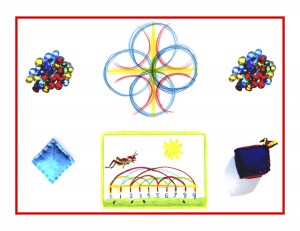
Day 151
For one year, 365 days, this blog will address the Common Core Standards from the perspective of creating an alternate, ambient learning environment for math. Ambient is defined as “existing or present on all sides, an all-encompassing atmosphere.” And ambient music is defined as: “Quiet and relaxing with melodies that repeat many times.
Why ambient? A math teaching style that’s whole and all encompassing, with themes that repeat many times through the years, is most likely to be effective and successful. Today’s post will begin reviewing the Common Core ELA standards, moving through them more quickly than the Common Core math standards. The standards will be posted in groups of three to five in blue, followed by their ambient counterparts.
English Language Arts Standards > Reading: Foundational Skills > Grade 2
Fluency:
Read with sufficient accuracy and fluency to support comprehension.
CCSS.ELA-LITERACY.RF2.4.A
Read grade-level text with purpose and understanding.
No direct reading as yet most likely, but the literature is way above grade-level complexity and content. Stories are told, retold, and related to academic lessons, so academics are concretized rather than abstracted, and anchored within a form and language spoken and understood by the child at this age. This may be seen as a secondary purpose (aside from the lofty purpose of the story itself), and a deeper understanding of both is obtained and enhanced by the joining of story and academics.
CCSS.ELA-LITERACY.RF2.4.B
Read grade-level text orally with accuracy, appropriate rate, and expression on successive readings.
Instead of reading orally, above-grade-level texts are retold with complex detail and total accuracy. The quality of imitation is still strong at this age, which may be thought of as a survival tool, until the child is strong and grown enough to take life on independently. We adults are the role models, quite literally, and we take that on willingly when we recognize that our children are not ready to think, reason, or act independently until age 11 or 12. We give them stories extracted from our collective cultural development, and then the children faithfully retell these stories with accuracy, appropriate rate, and expression, successively.
CCSS.ELA-LITERACY.RF2.4.C
Use context to confirm or self-correct word recognition and understanding, rereading as necessary.
Context is given as the story remains present throughout, whole and intact. Self-correction is minimal because the powers of imitation hold and remember the story deeply, so it remains present lifelong, as a faithful resource and source of inspiration. Understanding is thorough and consistent throughout. Reading occurs at the optimal time, leaping into complex chapter books while foregoing watered-down “grade-level” texts. Now is a good time to restate that my daughter, who attended Waldorf schools from grades 1-8, didn’t read independently until late third grade. She now reads voraciously as a doctoral candidate at Cal Berkeley. Have faith, and wait. Your child will shine, brilliantly when the time is right.
Knowledge ensues in an environment dedicated to imaginative, creative knowing, where student and teacher alike surrender to the ensuing of knowledge as a worthy goal. Tune in tomorrow to continue with the Common Core ELA standards and their ambient counterparts.
Tags:
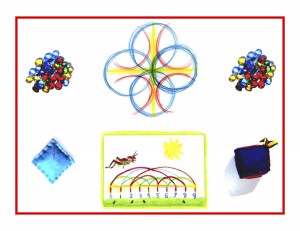
Day 150
For one year, 365 days, this blog will address the Common Core Standards from the perspective of creating an alternate, ambient learning environment for math. Ambient is defined as “existing or present on all sides, an all-encompassing atmosphere.” And ambient music is defined as: “Quiet and relaxing with melodies that repeat many times.
Why ambient? A math teaching style that’s whole and all encompassing, with themes that repeat many times through the years, is most likely to be effective and successful. Today’s post will begin reviewing the Common Core ELA standards, moving through them more quickly than the Common Core math standards. The standards will be posted in groups of three to five in blue, followed by their ambient counterparts.
English Language Arts Standards > Reading: Foundational Skills > Grade 2
Phonics and Word Recognition:
Know and apply grade-level phonics and word analysis skills in decoding words.
CCSS.ELA-LITERACY.RF2.3.A
Distinguish long and short vowels when reading regularly spelled one-syllable words.
CCSS.ELA-LITERACY.RF2.3.B
Know spelling-sound correspondences for additional common vowel teams.
CCSS.ELA-LITERACY.RF2.3.C
Decode regularly spelled two-syllable words with long vowels.
CCSS.ELA-LITERACY.RF2.3.D
Decode words with common prefixes and suffixes.
CCSS.ELA-LITERACY.RF2.3.E
Identify words with inconsistent but common spelling-sound correspondences.
CCSS.ELA-LITERACY.RF2.3.F
Recognize and read grade-appropriate irregularly spelled words.
Today’s post will be short and sweet. Short because there’s no match within the Waldorf approach to reading with the sort of analytical decoding listed here. Sweet because all of this can happen as naturally as your child learned to walk and speak. If a love of literature and reading is the foundation, then the bricks and mortar of reading skills will follow. Not because it’s drilled with worksheets and exercises, but because there’s a powerful desire to get at all of the lovely, compelling things to be found in books. I found this blog post from Bella Luna Toys as I searched for supportive information on the Waldorf approach to reading. Enjoy it, it’s wonderful.
#mce_temp_url#
Knowledge ensues in an environment dedicated to imaginative, creative knowing, where student and teacher alike surrender to the ensuing of knowledge as a worthy goal. Tune in tomorrow to continue with the Common Core ELA standards and their ambient counterparts.
Tags:
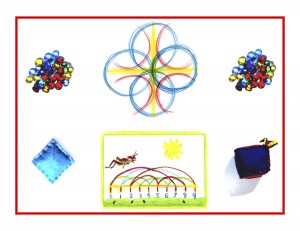
Day 149
For one year, 365 days, this blog will address the Common Core Standards from the perspective of creating an alternate, ambient learning environment for math. Ambient is defined as “existing or present on all sides, an all-encompassing atmosphere.” And ambient music is defined as: “Quiet and relaxing with melodies that repeat many times.
Why ambient? A math teaching style that’s whole and all encompassing, with themes that repeat many times through the years, is most likely to be effective and successful. Today’s post will begin reviewing the Common Core ELA standards, moving through them more quickly than the Common Core math standards. The standards will be posted in groups of three to five in blue, followed by their ambient counterparts.
English Language Arts Standards > Reading: Informational Text > Grade 2
Integration of Knowledge and Ideas:
CCSS.ELA-LITERACY.RI.2.7
Explain how specific images (e.g., a diagram showing how a machine works) contribute to and clarify a text.
CCSS.ELA-LITERACY.RI.2.8
Describe how reasons support specific points the author makes in a text.
CCSS.ELA-LITERACY.RI.2.9
Compare and contrast the most important points presented by two texts on the same topic.
Range of Reading and Level of Text Complexity:
CCSS.ELA-LITERACY.RI.2.10
By the end of year, read and comprehend informational texts, including history/social studies, science, and technical texts, in the grades 2-3 text complexity band proficiently, with scaffolding as needed at the high end of the range.
Technology in any form is beyond the understanding of a typical 8 year old. It has been shown by child development psychologists that the true age of reason is not reached until 11 or 12. Until that time, foisting premature understanding onto undeveloped capacities can only result in frustration at best and extreme stress at worst. As the name implies, handwork is work done exclusively by hand, practiced in Waldorf grades up to seven or eight, when the sewing machine is introduced to produce a simple, straight-seam project like sewing a pair of pajama pants.
“Reasons” . . . that inappropriate word again. The child up to age 11 or 12 is quite literal in his or her understanding. Everything is what it seems to be, with no real underlying reasons. A parallel for this mode of thinking is the flat, 2-dimensional plane found in most children’s art. Look at a first grade landscape drawing. You’ll most likely see the sun fixed in a top corner, a band of blue sky across the top, empty space in the middle, and a band of green and brown earth at the bottom. There is no understanding yet of the sky meeting the horizon, instead the blank middle space represents the very air we breathe. Perspective drawing is taught in the Waldorf seventh grade because the child’s consciousness has matured to the point where a 3-dimensional understanding of space is possible. And this expanded consciousness extends to the ability to reason and to perceive others’ reasoning. Not yet!
Compare and contrast: an excellent tool for writing an essay. Too soon however. If the ability to reason has not happened, it is difficult, challenging, and most importantly stress-inducing, to expect this level of writing skill and organization of the 8 year old. As always though, a solid foundation can be built! Two versions of the same story could be told, with two different outcomes. For example, Reynard the Fox could successfully raid the hen house in one version, and be foiled in his attempts by the barnyard dog or cat in the second version. The compare and contrast element could happen more subtly in the telling, retelling, and in the illustrations and academic application of the stories. Most importantly, these abilities are allowed to “sleep” until the optimal time for awakening arrives.
History and social studies are taught indirectly through stories. The moral element shines through all of the literature presented in the younger grades, up to fifth grade (the dawning of the child’s reasoning powers) when the Ancient Civilizations of Greece. Egypt, and India are revealed through story and art. When the modern era is reached in the eighth grade, history continues to be graced with story in the form of anecdotes and biographies. Since independent reading is not yet expected, no scaffolding is needed. Though the literature that’s told, retold, and applied is developmentally appropriate, its quality and content are not watered down to allow independent reading.
Knowledge ensues in an environment dedicated to imaginative, creative knowing, where student and teacher alike surrender to the ensuing of knowledge as a worthy goal. Tune in tomorrow to continue with the Common Core ELA standards and their ambient counterparts.
Tags:
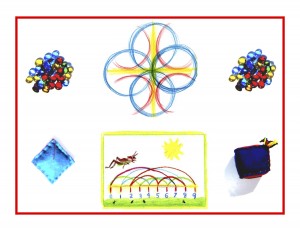
Day 148
For one year, 365 days, this blog will address the Common Core Standards from the perspective of creating an alternate, ambient learning environment for math. Ambient is defined as “existing or present on all sides, an all-encompassing atmosphere.” And ambient music is defined as: “Quiet and relaxing with melodies that repeat many times.
Why ambient? A math teaching style that’s whole and all encompassing, with themes that repeat many times through the years, is most likely to be effective and successful. Today’s post will begin reviewing the Common Core ELA standards, moving through them more quickly than the Common Core math standards. The standards will be posted in groups of three to five in blue, followed by their ambient counterparts.
English Language Arts Standards > Reading: Informational Text > Grade 2
Craft and Structure:
CCSS.ELA-LITERACY.RI.2.4
Determine the meaning of words and phrases in a text relevant to a grade 2 topic or subject area.
CCSS.ELA-LITERACY.RI.2.5
Know and use various text features (e.g., captions, bold print, subheadings, glossaries, indexes, electronic menus,icons) to locate key facts or information in a text efficiently.
CCSS.ELA-LITERACY.RI.2.6
Identify the main purpose of a text, including what the author wants to answer, explain, or describe.
Exploring literature that is not relevant to grade level is one of the rock-solid advantages of a Waldorf education. Trying to squeeze adult content (which most informational text by its nature is) into a watered-down version just to make it possible for an 8 year old to struggle through is mistaken. Why put the cart before the horse? Why go through all the steps to teach reading in a dissected way when it can grow naturally, as an offshoot of a love of story. Story and myth constitute the proper diet for the young child. Time enough for the facts, later.
Doesn’t this list of text features imply computer use? Real paper doesn’t seem to be read anymore. We can get anything we need off our screens, large or small. Screen use has been proven to be detrimental (even physically) under the age of reason, which most developmental research has set at 11-12. Reading efficiently and second graders are not in the same ball park, i.e., yesterday’s image of an 8 year old thoughtfully reading the morning paper. In the Waldorf system, second graders make their own textbooks/main lesson books by illustrating each day’s lesson (usually in tandem with the day before’s story) and writing the content of the lesson on the facing page. First graders block print in all caps, second graders switch to upper and lower case letters, and third graders learn to write in cursive. The text features listed in this standard do appear in the children’s writing, but are not abstractly taught at this level.
The main purpose of a text is intuitively grasped as the story unfolds and is retold the next day. Elements of literature are valuable learning tools, but developmentally inappropriate when taught abstractly at this grade level. “Answer, explain, or describe” may be a better fit with informational text than storytelling, but can be found intricately woven into the story, and as such can build a sturdy foundation for reading informational text later on.
Knowledge ensues in an environment dedicated to imaginative, creative knowing, where student and teacher alike surrender to the ensuing of knowledge as a worthy goal. Tune in tomorrow to continue with the Common Core ELA standards and their ambient counterparts.
Tags:

